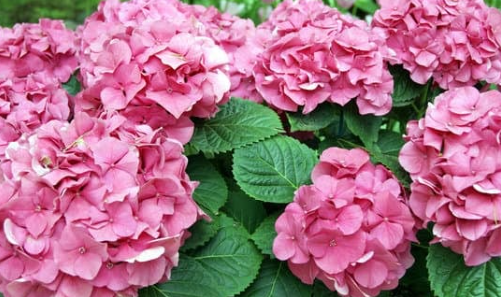
Hydrangeas are a fantastic flowering shrub, known for their large, showy blooms that can range from vibrant pinks and purples to serene blues and whites. With their lush foliage and long blooming period, hydrangeas make a perfect addition to any garden. In Ireland, we have a temperate climate and lots of rain, hydrangeas love this and thrive. Here’s my guide to growing hydrangeas from choosing the right varieties to make sure they flourish in your garden.
Why Hydrangeas love Ireland
Ireland’s climate is ideal for hydrangeas. The mild temperatures and consistent moisture create the perfect environment for these plants to grow vigorously. Unlike some other areas, where extreme heat or cold can stress hydrangeas, Ireland’s temperate conditions allow these plants to maintain their beauty throughout the growing season. Additionally, the country’s slightly acidic soil is perfect for growing the vibrant blue and purple shades.

Choosing the Right Hydrangea Varieties
There are several types of hydrangeas, each with its own unique characteristics. When selecting hydrangeas for your garden, consider the following popular varieties:
Hydrangea macrophylla (Bigleaf Hydrangea):
- Known for its large, rounded flower heads, Bigleaf Hydrangeas are the most commonly grown in Ireland. They come in two main forms: mophead and lace cap. Mopheads have dense, ball-shaped clusters of flowers, while lace caps have flat, delicate blooms surrounded by a ring of larger petals.
- Colour: The colour of Bigleaf Hydrangea blooms is influenced by soil pH. Acidic soils produce blue flowers, while alkaline soils yield pink blooms. This makes them particularly fascinating for gardeners who enjoy experimenting with soil amendments.

Hydrangea paniculata (Panicle Hydrangea):
- Panicle Hydrangeas are known for their cone-shaped flower clusters that start white and often turn pink as they mature. They are hardier than Bigleaf Hydrangeas and can tolerate colder temperatures, making them a great choice for gardens in northern or higher altitude areas of Ireland.
- Growth: These hydrangeas are more tolerant of direct sunlight and can be pruned to maintain a desired shape and size.

Hydrangea arborescens (Smooth Hydrangea):
- Smooth Hydrangeas are valued for their reliability and ease of care. They produce large, round flower heads, typically white, and are more tolerant of different soil types.
- Advantages: They bloom on new wood, meaning they can be cut back in the winter and still produce flowers the following summer.

Planting Hydrangeas in Ireland
When planting hydrangeas, location is key. Here are some tips to ensure your hydrangeas get off to a good start:
- Location: Choose a spot with morning sun and afternoon shade. While hydrangeas appreciate sunlight, too much direct afternoon sun can cause wilting and stress, particularly during dry spells.
- Soil: Hydrangeas prefer well-draining, fertile soil. In Ireland, the naturally occurring slightly acidic soil is beneficial for producing blue blooms in Bigleaf Hydrangeas. If your soil is too alkaline, consider adding composted organic matter or a soil acidifier to lower the pH.
- Watering: Hydrangeas have a high water requirement, especially during dry periods. Ensure the soil remains consistently moist but not waterlogged. Mulching around the base of the plants can help retain moisture and keep the roots cool.
- Planting: Dig a hole twice the width of the root ball but no deeper. Place the hydrangea in the hole, backfill with soil, and water thoroughly. Space multiple plants about 1.5 to 2 meters apart to allow for growth and airflow.

Caring for Hydrangeas
Once planted, hydrangeas require regular care to thrive. Here’s how to keep your hydrangeas healthy and blooming:
Pruning:
For Bigleaf Hydrangeas, prune immediately after flowering, typically in late summer or early autumn. This allows the plant to set buds for the following year.
Panicle and Smooth Hydrangeas can be pruned in late winter or early spring since they bloom on new wood.
Fertilizing: Apply a balanced, slow-release fertilizer in early spring to promote healthy growth. Avoid over-fertilizing, as this can lead to lush foliage but fewer flowers.
Pest and Disease Control: Hydrangeas are generally resilient, but they can be susceptible to issues like powdery mildew, leaf spots, and aphids. Ensure good air circulation, avoid overhead watering, and treat any infestations promptly with appropriate organic or chemical controls.
Winter Protection: While most hydrangeas are hardy in Ireland’s climate, a harsh winter can damage flower buds, particularly on Bigleaf Hydrangeas. Consider mulching around the base of the plant in late autumn to protect the roots, and cover young plants with fleece during particularly cold spells.

Enhancing Hydrangea Colour
One of the most fascinating aspects of growing hydrangeas is the ability to influence their bloom colour. This is particularly true for Bigleaf Hydrangeas:
- Blue Blooms: To maintain or achieve blue flowers, keep the soil pH between 5.2 and 5.5. Adding aluminium sulphate to the soil can help achieve this.
- Pink Blooms: For pink blooms, the soil pH should be above 6.0. Adding garden lime can raise the pH.
- White Blooms: White hydrangeas generally do not change colour based on soil pH.

Growing hydrangeas in Ireland can be a rewarding experience, with these beautiful plants offering long-lasting blooms and a variety of colours and forms. By choosing the right varieties, planting in suitable conditions, and providing proper care, you can enjoy the stunning display of hydrangeas in your garden year after year. Whether you prefer the rich blues and purples or the elegant whites and pinks, hydrangeas are sure to bring a touch of vibrancy to any garden
